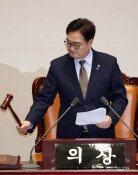President Yoon visits Command Post Tango in Seongnam
President Yoon visits Command Post Tango in Seongnam
Posted August. 24, 2023 08:41,
Updated August. 24, 2023 08:41

The South Korean military initially considered simulating a North Korean nuclear attack during the joint Ulchi Freedom Shield (UFS) exercise with the U.S. The idea was discussed and negotiated but was ultimately aborted due to the existing operational control (OPCON) arrangement. Instead, the exercise focused on simulating a conventional imminent North Korean attack. However, there’s a rising demand for including simulated North Korean nuclear attacks in future exercises or creating a separate wartime operational control plan.
On Monday, the first day of the joint military exercise, President Yoon Suk Yeol expressed concerns over North Korea’s willingness to use nuclear weapons to achieve its goals, which seems to have been attributable to the perception as the above.
According to The Dong-A Ilbo’s coverage, during the planning phase of the UFS Exercise scheduled for the second half of this year, the South Korean military strongly considered including a simulated North Korean nuclear attack scenario. An insider mentioned that officials contemplated including a simulation of North Korea launching short-range ballistic missiles (SRBM) toward South Korean territory, either inland or at sea. The biannual South Korea-U.S. joint military exercise has thus far focused on simulating scenarios involving an impending North Korean nuclear attack, not the actual attack.
Reports indicate that Seoul and Washington have agreed to exclude a simulation of a real nuclear attack in this year’s UFS Exercise. This decision aligns with the existing OPCON plan, which lacks provisions for a nuclear umbrella as a response to North Korean nuclear attacks. The ROK-US Combined Forces Command has also reportedly clarified that the existing plan does not encompass a real nuclear attack from North Korea.
Sang-Ho Yun ysh1005@donga.com







